Common Merganser Duck
- February 19, 2024
- 0 comment
The Common Merganser, a strikingly beautiful species of waterfowl, is renowned for its distinctive appearance and remarkable diving capabilities. Found across North America, Europe, and parts of Asia, these ducks possess a captivating blend of elegance and functionality. The males sport a striking combination of snowy white bodies, contrasting black backs, and iridescent green heads, while the females exhibit a more subdued palette of gray with a rusty-red head. With their long, slender bodies, serrated bills, and webbed feet, Common Mergansers are well-adapted for life in freshwater habitats such as rivers, lakes, and ponds.

They are skilled hunters, primarily preying on fish, crustaceans, and aquatic insects, using their keen eyesight to spot prey before executing swift underwater dives. During the breeding season, they form monogamous pairs and select nesting sites in secluded areas near water bodies, where they construct nests using vegetation and down feathers. Despite facing threats such as habitat loss and pollution, concerted conservation efforts are underway to safeguard the future of these magnificent birds. The Common Merganser serves as a symbol of resilience and adaptability in the face of environmental challenges, captivating the hearts of birdwatchers and nature enthusiasts worldwide.
| Specification | Description |
|---|---|
| Scientific Name | Mergus merganser |
| Family | Anatidae |
| Size | Large-bodied |
| Length (Male) | Approximately 25-28 inches (63-71 cm) |
| Length (Female) | Slightly smaller than males |
| Plumage | Sexual dimorphism |
| Male Plumage | White body, black back, iridescent green head |
| Female Plumage | Gray body, rusty-red head |
| Bill | Long, serrated |
| Feet | Webbed |
| Habitat | Freshwater habitats such as rivers, lakes, ponds |
| Distribution | North America, Europe, parts of Asia |
| Diet | Fish, crustaceans, aquatic insects |
| Feeding Behavior | Skilled divers, catch prey underwater |
| Breeding Behavior | Monogamous pairs |
| Nesting Sites | Secluded areas near water bodies |
| Nest Construction | Vegetation, down feathers |
| Conservation Status | Least Concern (IUCN) |
| Threats | Habitat loss, pollution, human disturbance |
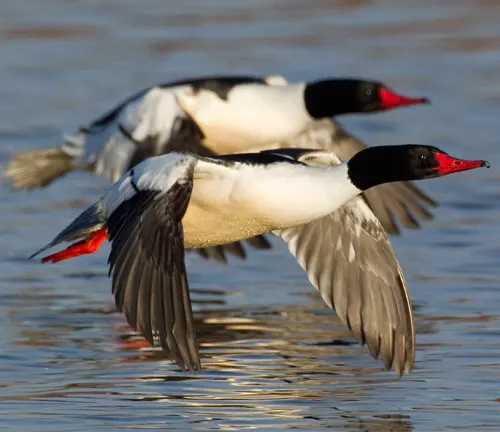
The Common Merganser, scientifically known as Mergus merganser, is a species of diving duck found across North America, Europe, and parts of Asia. With its distinctive appearance and behavior, the Common Merganser is a fascinating bird that has captured the interest of birdwatchers and conservationists alike.
Physical Description
Plumage
The Common Merganser exhibits striking sexual dimorphism in its plumage. Males boast a bold combination of white bodies, black backs, and iridescent green heads, creating a stunning contrast that is unmistakable in the waterfowl world. In contrast, females sport a more subdued appearance, with gray bodies and rusty-red heads. This difference in plumage between males and females serves various purposes, including camouflage during nesting and courtship displays to attract potential mates.

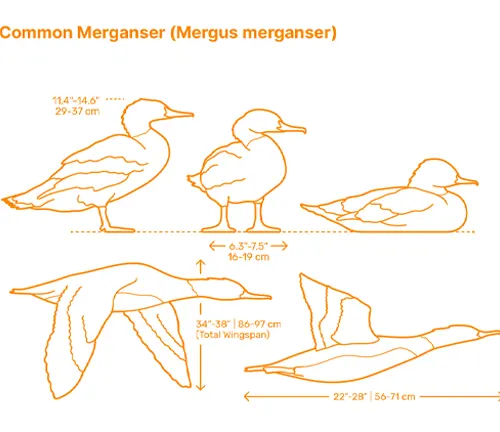
Size and Shape
Common Mergansers are large-bodied ducks, with males typically measuring between 25 to 28 inches (63 to 71 cm) in length, while females are slightly smaller. They have long, slender bodies that are streamlined for efficient swimming and diving. Their elongated shape allows them to move gracefully through the water, while their webbed feet provide propulsion. Additionally, Common Mergansers possess a characteristic serrated bill, known as a “sawbill,” which is specialized for catching and holding onto slippery prey such as fish. This unique adaptation reflects their piscivorous diet and distinguishes them from other species of ducks.
Habitat and Distribution
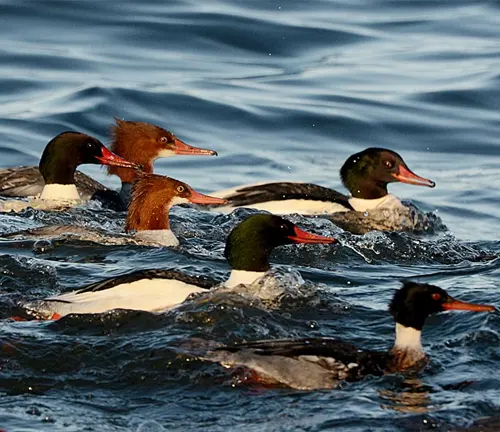
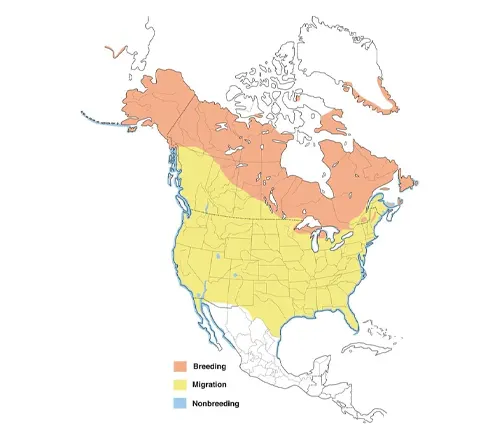
Common Mergansers are highly adaptable birds that inhabit a wide range of freshwater habitats across North America, Europe, and parts of Asia. They can be found in various aquatic environments, including rivers, lakes, ponds, and marshes. These ducks are particularly fond of habitats with clear, unpolluted water and abundant fish populations, as they primarily feed on fish.
Their distribution varies depending on the season. During the breeding season, Common Mergansers are commonly found in northern regions, including boreal forests and mountainous areas, where they nest and raise their young. As migratory birds, they undertake seasonal movements, migrating south to warmer regions during the winter months. In winter, they can be observed in more temperate climates, often congregating in large flocks in open water areas or along coastlines.
Feeding Habits
Common Mergansers are highly specialized divers and skilled hunters, primarily preying on fish. Their diet also includes crustaceans, aquatic insects, and occasionally small amphibians. They employ a variety of feeding strategies to capture their prey efficiently.
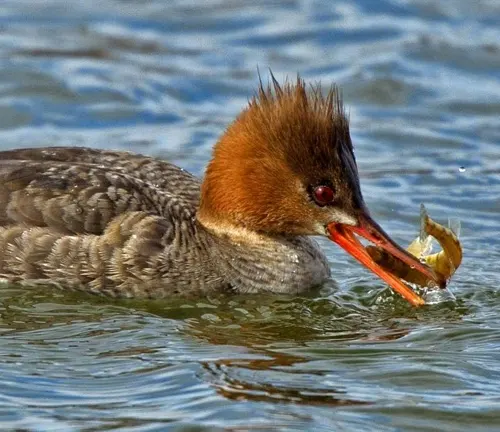
One of the most remarkable aspects of Common Mergansers’ feeding behavior is their ability to dive underwater in search of food. They use their keen eyesight to spot prey from the surface, often from a considerable distance above the water. Once they’ve detected potential prey, such as fish swimming below, they swiftly dive beneath the surface, propelled by their powerful webbed feet.
Once underwater, Common Mergansers use their serrated bills, also known as “sawbills,” to grasp and secure their slippery prey. The serrations on their bills help them hold onto fish, preventing them from escaping. Common Mergansers can stay submerged for extended periods, allowing them to forage effectively in deeper waters.
Breeding Behavior
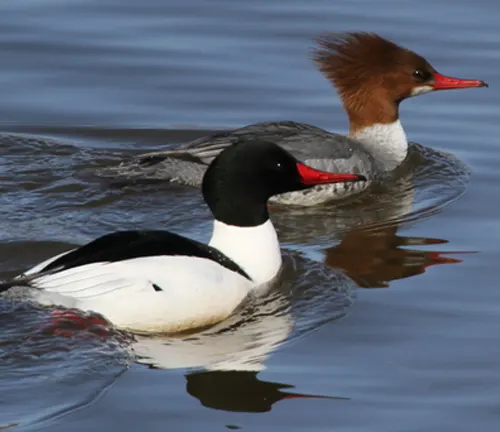
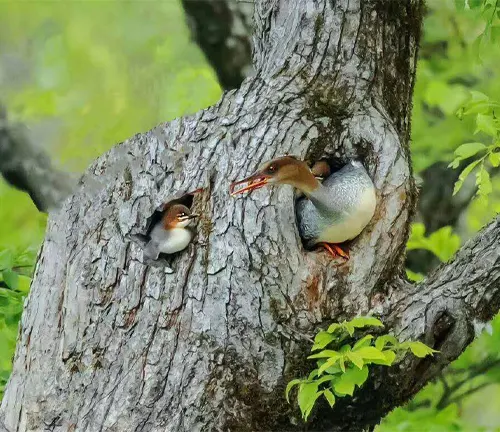
During the breeding season, Common Mergansers exhibit fascinating behaviors related to courtship, mate selection, and nest building. Here’s an overview of their breeding behavior:
- Monogamous Pairs: Common Mergansers typically form monogamous pairs, where a male and female bond together for the duration of the breeding season. These pairs often remain together until the end of the nesting period, and in some cases, may form long-term pair bonds.
- Courtship Displays: Males engage in elaborate courtship displays to attract females. These displays can include head bobbing, wing flapping, and synchronized swimming, demonstrating the male’s fitness and suitability as a mate.
- Mate Selection: Female Common Mergansers are selective when choosing a mate. They may assess a male’s displays, plumage quality, and overall health before forming a pair bond. Once a pair bond is established, the male remains attentive to the female, often guarding her and the nest from potential threats.
- Nesting Sites: Female Common Mergansers select nesting sites in secluded areas near water bodies, such as rivers, lakeshores, or wetlands. They prefer sites with adequate vegetation cover and minimal human disturbance. Nesting sites may vary depending on geographic location and habitat availability.
- Nest Construction: Once a nesting site is chosen, the female constructs the nest using a combination of vegetation, twigs, and down feathers. The nest is typically positioned close to the water’s edge, providing easy access to foraging areas and protection from predators.
- Egg Laying and Incubation: After the nest is built, the female lays a clutch of eggs, typically ranging from 6 to 17 eggs, depending on factors such as age, health, and environmental conditions. She then incubates the eggs for approximately 28 to 35 days, during which time the male may provide food and protection.
- Hatching and Rearing: Once the eggs hatch, the female leads the ducklings to water, where they begin to forage and develop their swimming skills. Common Mergansers are attentive parents, guiding and protecting their young from predators until they are capable of independent foraging.
can - Fledging: As the ducklings grow and develop, they gradually gain strength and independence. After several weeks, they fledge and are capable of sustained flight, though they may remain with their parents for a short time before dispersing.
Mating Rituals
Males engage in elaborate courtship displays to attract females, which may include head bobbing, wing flapping, and synchronized swimming. Once paired, the male remains vigilant, guarding the female and nest from potential threats.
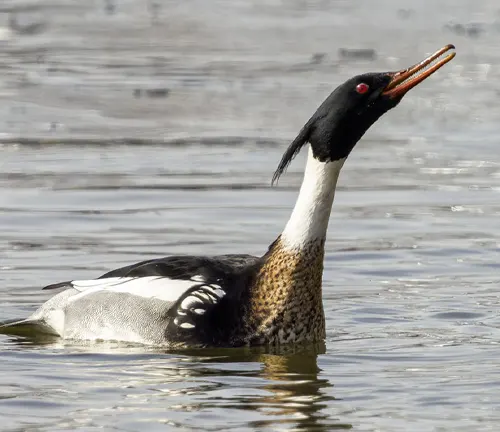
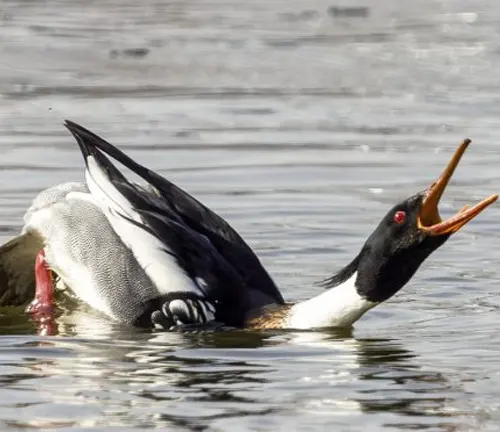
- Head Bobbing: Head bobbing is a fundamental mating ritual for Common Mergansers. Males rhythmically move their heads up and down while swimming, accompanied by vocalizations. This behavior signals the male’s readiness to mate and serves to attract the attention of females, demonstrating his fitness and suitability as a potential mate.
- Wing Flapping: Wing flapping is another key mating ritual observed in Common Mergansers. Males vigorously flap their wings while swimming or standing on the water’s surface, creating a visual spectacle that showcases their strength and agility. Wing flapping displays serve to impress females and reinforce the male’s dominance and fitness as a mate.
- Synchronized Swimming: Synchronized swimming is a coordinated courtship behavior observed between male and female Common Mergansers. They swim together in synchronized patterns, mirroring each other’s movements and demonstrating their compatibility as potential mates. This ritual strengthens the pair bond and enhances the likelihood of successful mating and reproduction.
Nesting Habits
Common Mergansers prefer to nest in natural cavities or abandoned woodpecker holes in trees near water. However, they have also been known to use nest boxes provided by conservation efforts.
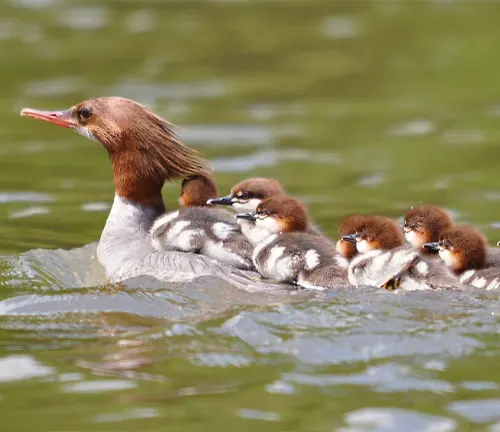
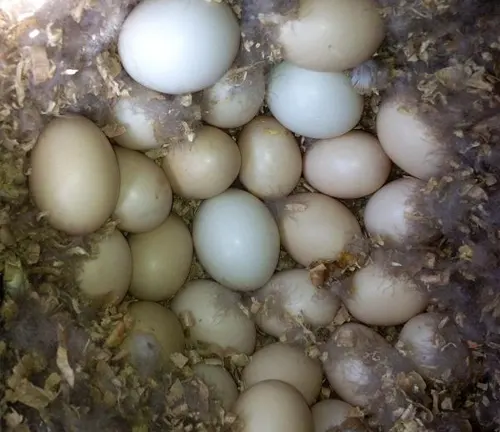
- Selection of Nesting Sites: Common Mergansers are selective in choosing nesting sites, preferring secluded areas near water bodies such as rivers, lakeshores, or wetlands. These locations offer protection from predators and human disturbance, ensuring the safety of the nesting pair and their offspring.
- Nest Construction: Female Common Mergansers meticulously construct their nests using a combination of materials such as twigs, grasses, leaves, and down feathers. The nest is carefully shaped to provide a secure and comfortable environment for incubating eggs and raising ducklings.
- Incubation and Parental Care: Once the eggs are laid, both male and female Common Mergansers play a crucial role in incubating the eggs and caring for the ducklings after hatching. They take turns keeping the eggs warm and protected from predators, ensuring the successful hatching and survival of their offspring.
Conservation Status
The Common Merganser is classified as a species of “Least Concern” by the International Union for Conservation of Nature (IUCN). This designation indicates that the species is not currently facing imminent threats to its survival and is considered to have a stable population trend across its range.
Threats and Challenges
Habitat Loss
Urbanization, land development, and conversion of natural habitats pose significant threats to Common Merganser populations. Wetlands, rivers, and lakes—the preferred habitats of Common Mergansers—are often subjected to habitat loss due to human activities. The draining of wetlands for agriculture, construction of dams and reservoirs, and deforestation along water bodies all contribute to the degradation and loss of suitable habitat for Common Mergansers.
Loss of habitat not only reduces the availability of nesting sites but also diminishes the abundance of food sources and disrupts important migratory pathways. As a result, Common Merganser populations may decline in areas where habitat loss is prevalent, impacting their overall distribution and reproductive success.
Pollution
Pollution of water bodies poses another significant threat to Common Mergansers. Agricultural runoff, industrial discharge, sewage effluents, and oil spills contaminate freshwater ecosystems, compromising water quality and affecting the health of aquatic organisms—including the fish and invertebrates that Common Mergansers rely on for food.
Pollutants such as pesticides, heavy metals, and chemicals accumulate in the food chain, bioaccumulating in the tissues of Common Mergansers and other wildlife. Exposure to pollutants can lead to adverse health effects, including reproductive disorders, immune system suppression, and developmental abnormalities, ultimately impacting the survival and reproductive success of Common Mergansers.
Conservation Efforts
Conservation organizations and government agencies are implementing measures to protect and restore wetland habitats, regulate water quality, and raise awareness about the importance of preserving biodiversity.
Habitat Restoration and Protection
One of the most critical conservation efforts for Common Mergansers is habitat restoration and protection. This involves restoring degraded wetlands, rivers, and lakes, as well as protecting existing habitats from further destruction or development. By preserving and enhancing suitable nesting and foraging habitats, conservationists can support healthy Common Merganser populations.
Pollution Control Measures
Implementing pollution control measures is essential for safeguarding Common Mergansers from the detrimental effects of water pollution. This includes regulating industrial discharges, agricultural runoff, and sewage effluents to minimize contaminants entering water bodies. Pollution control efforts help maintain water quality, ensuring the availability of clean and safe habitats for Common Mergansers and other aquatic species.
Community Engagement and Education
Engaging local communities and raising awareness about the importance of Common Merganser conservation is crucial for garnering support and fostering stewardship of natural resources. Conservation organizations conduct educational programs, workshops, and outreach activities to empower communities to participate in conservation efforts, such as habitat restoration, pollution prevention, and responsible recreation practices.
Research and Monitoring Programs
Conducting research and monitoring programs provides valuable insights into Common Merganser populations, habitat requirements, and threats. Conservationists collect data on population trends, nesting success, and habitat usage to inform conservation strategies and prioritize conservation actions effectively. By continuously monitoring Common Merganser populations and their habitats, conservationists can adapt management approaches and address emerging threats in a timely manner.
Interesting Facts
- Common Mergansers are highly social birds and are often observed in large flocks during migration.
- They are known for their distinctive “sawbill” which helps them grasp slippery prey items.
- Common Mergansers are strong flyers and can travel long distances during migration.
Different Species
Red-breasted Merganser
(Mergus serrator)
This species is closely related to the Common Merganser and is found in North America, Europe, and Asia. It is distinguished by its reddish-brown breast and long, slender bill.
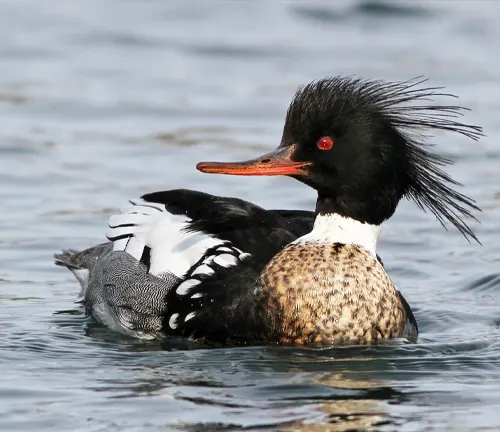
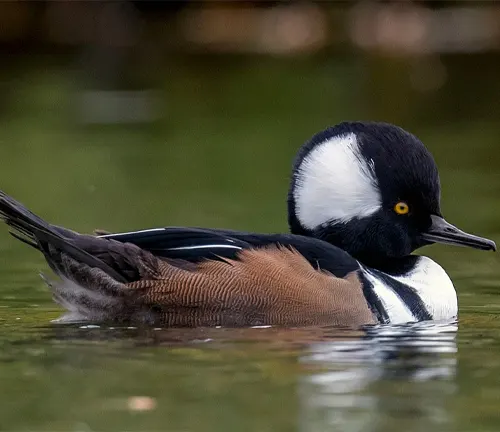
Hooded Merganser
(Lophodytes cucullatus)
While not part of the Mergus genus, the Hooded Merganser is another species of merganser found in North America. It is characterized by its distinctive black and white crest, which males can erect during courtship displays.
Scaly-sided Merganser
(Mergus squamatus)
This species is native to East Asia, particularly China, Russia, and Japan. It is named for the scalloped or scaly appearance of its flanks. The Scaly-sided Merganser is listed as endangered due to habitat loss and degradation.
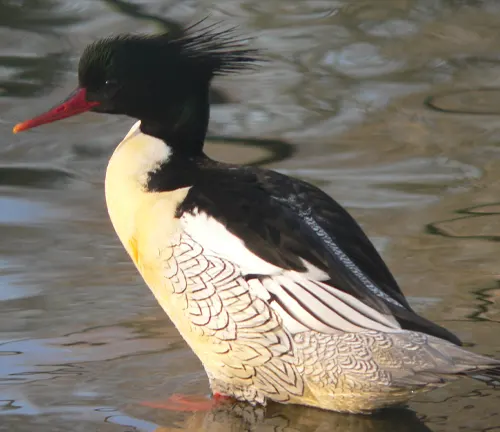
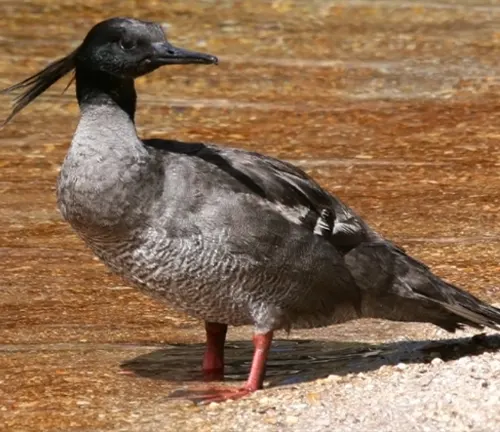
Brazilian Merganser
(Mergus octosetaceus)
Endemic to Brazil, this species is one of the rarest ducks in the world. It is characterized by its dark plumage and distinctive white facial markings. The Brazilian Merganser is critically endangered due to habitat destruction and hunting.
Frequently Asked Questions (FAQs)
- Where are Common Mergansers found?
Common Mergansers are found across North America, Europe, and parts of Asia, inhabiting freshwater habitats such as rivers, lakes, and ponds. - What do Common Mergansers eat?
Common Mergansers primarily feed on fish, but they also consume crustaceans, aquatic insects, and occasionally small amphibians. - Are Common Mergansers migratory birds?
Yes, Common Mergansers are migratory birds. They breed in northern regions during the summer and migrate south to warmer areas during the winter months. - How do Common Mergansers catch their prey?
Common Mergansers are skilled divers and use their sharp, serrated bills to catch fish underwater. They spot prey from the surface and swiftly dive to capture it. - Do Common Mergansers form monogamous pairs?
Yes, Common Mergansers typically form monogamous pairs during the breeding season. Males engage in elaborate courtship displays to attract females. - What is the lifespan of a Common Merganser?
The average lifespan of a Common Merganser in the wild is around 10-15 years. - Do Common Mergansers nest in trees?
Yes, Common Mergansers often nest in natural cavities or abandoned woodpecker holes in trees near water bodies. They may also use nest boxes provided by conservation efforts. - Are Common Mergansers aggressive birds?
Common Mergansers are not typically aggressive towards humans unless provoked or disturbed. They are more focused on finding food and caring for their young. - How do Common Mergansers communicate?
Common Mergansers use a variety of vocalizations to communicate with each other, including soft quacks, grunts, and whistles. - What are the main threats to Common Mergansers?
The main threats to Common Mergansers include habitat loss, pollution of water bodies, human disturbance, and nesting site destruction. - Can Common Mergansers fly long distances?
Yes, Common Mergansers are strong flyers and can travel long distances during migration, often forming large flocks. - How do Common Mergansers protect their young?
Common Merganser parents are vigilant in protecting their young from predators. They may use distraction displays or aggressive behaviors to deter potential threats.


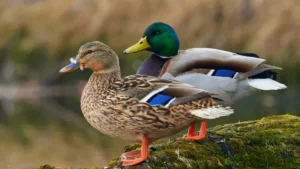
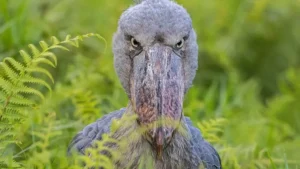


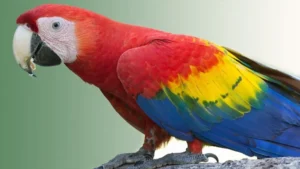

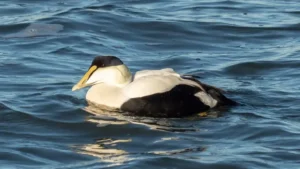
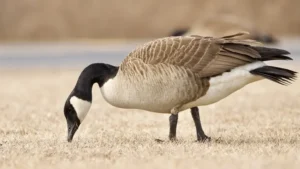

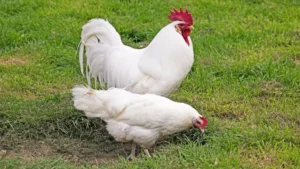
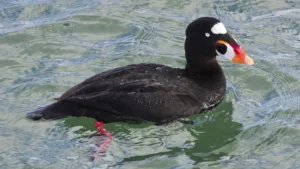
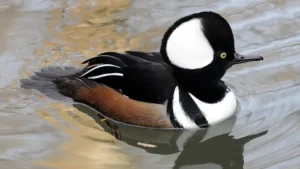
Leave your comment